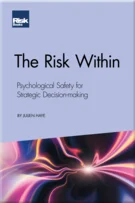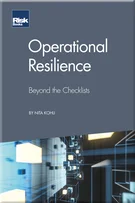Unlocking KRIs
Unlocking KRIs
Introduction
Operational Risk in Four Letters
An Invisible Framework
Small is Beautiful in OpRisk Management
The Business Value of ORM
How to Minimise ‘People Risk’
The Missing Piece
Risk Appetite and Framework
From Russian Roulette to Overcautious Decision-making
The Importance of Preventive KRIs
How to Build Preventive Key Risk Indicators
Unlocking KRIs
Six Steps for Preventive KRIs
Have Your Cake and Eat It
Conduct, Not ‘Conduct Risk’
How to Manage Incentives
Is Reputation Risk Overstated?
What Regulators Want
Conduct & Culture
OpRisk Takes Forward Steps at OpRisk Europe 2014
Modern Scenario Analysis
The Rogue’s Path
Rogue Trading No Training: The Connections
What Brexit Teaches OpRisk
OpRisk Survey Shows the Insidious Effects of Political Risk
Discarding the AMA Could Become a Source of OpRisk
UCL Research Shows that SMA Reforms Introduces Capital Instability and Discourages Risk Management
Memo to Bank CEOs: Treat OpRisk with More Respect
Don’t Let the SMA Kill OpRisk Modelling
You can count on one hand the number of organisations fully satisfied with their KRIs. Beyond their core business, many organisations struggle to have a clear view of what constitutes an efficient KRI suite.
A classification of KRIs based on four categories – exposure, stress, causal and failure – would bring a wealth of benefits: insisting on the necessity of preventative KRIS, addressing the causes of risks rather than events, helping to track changes in the environment, increasing resource stretch before the business is damaged (rather than reporting lagging trends) and highlighting the links between performance, control and risk indicators.
ADDRESSING EXPOSURE
Exposure indicators relate to the nature of the business environment and to its critical dependencies. The business environment may be volatile or stable, growing or mature, regulated or free. Critical dependencies include main suppliers and vendors, large clients, essential systems or key staff. Accepting a given business environment and critical dependencies are risk appetite decisions. Next, monitoring any changes to this accepted level of risk is part of a comprehensive KRI programme.
Crucially, exposure
Copyright Infopro Digital Limited. All rights reserved.
As outlined in our terms and conditions, https://www.infopro-digital.com/terms-and-conditions/subscriptions/ (point 2.4), printing is limited to a single copy.
If you would like to purchase additional rights please email info@risk.net
Copyright Infopro Digital Limited. All rights reserved.
You may share this content using our article tools. As outlined in our terms and conditions, https://www.infopro-digital.com/terms-and-conditions/subscriptions/ (clause 2.4), an Authorised User may only make one copy of the materials for their own personal use. You must also comply with the restrictions in clause 2.5.
If you would like to purchase additional rights please email info@risk.net











